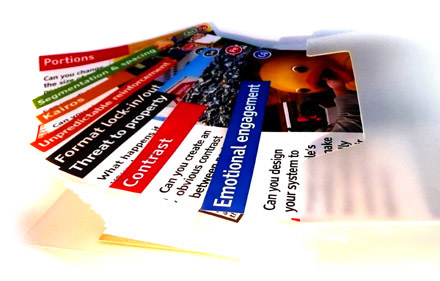
It’s been a long time coming, but a year after v.0.9, the new Design with Intent toolkit, DwI v.1.0, is ready. Officially titled Design with Intent: 101 Patterns for Influencing Behaviour Through Design, it’s in the form of 101 simple cards, each illustrating a particular ‘gambit‘ for influencing people’s interactions with products, services, environments, and each other, via the design of systems. They’re loosely grouped according to eight ‘lenses‘ bringing different disciplinary perspectives on behaviour change.
The cards (Download them here)
The intention is that the cards are useful at the idea generation stage of the design process, helping designers, clients and – perhaps most importantly – potential users themselves explore behaviour change concepts from a number of disciplines, and think about how they might relate to the problem at hand. Judging by the impact of earlier iterations, the cards could also be useful in stakeholder workshops, and design / technology / computer science education.
Read More